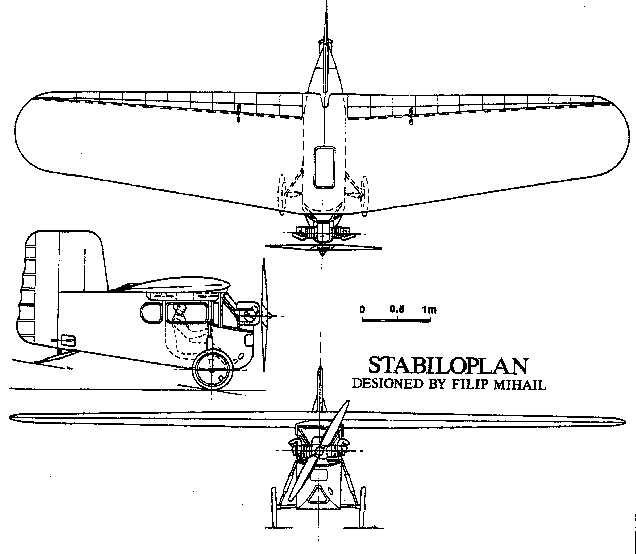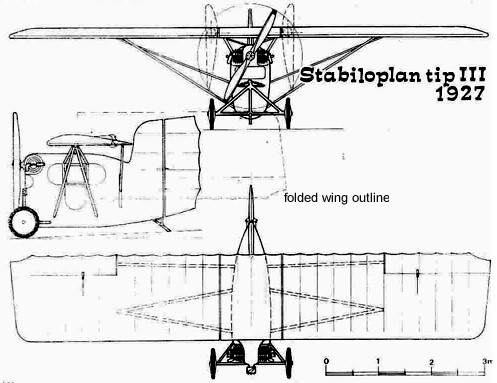The STABLE-PLANE
Created by Filip Mihail
By Neculai Moghior and Elena
Voicil?
(Translated by an unknown author from an unknown,
probably Romanian, publication.)
The creator of
this flight apparatus, Filip Mihail, an aviation technician, was born in
Cernica in 1896 in a poor farmer family. After graduating an apprentice
school, he was hired as a worker in the Aeronautical Storeyard in Cotroceni
(a Bucharest district), where he became specialized in maintenance operations,
in designing and building aeroplanes.
During World War
I, being part of the ‘Army Aviation Reserve Division’, Filip Mihail was
remarked due to his ability and skill he proved in repairing various types
of planes. After the war was over, he worked for a while in the Aeronautical
Storeyard and in the IAR Barsov; later on he left for France where
he would specialize working in several factories; his preoccupations went
to building of a new aeroplane type.
On April 4, 1923,
he obtained the Invention Patent No. 555924 issued by the French Ministry
of Trade and Industry for a monoplane gyro-aircraft, based on the documentation
he had submitted on August 19, 1922 in Paris. The monoplane gyro-aircraft
was name ‘Peace’ (La Paix) and its construction was taking over a series
of constructive elements found in Vlaicu’s and Vuia’s planes: the ‘parasol’
(sun-protected) wing made of a metal frame covered by textiles, the ‘gondola’-type
cockpit, the landing gear and the transmission system between the engine
and the propeller. The elevator rudders were cancelled, their role
being taken over by the wint sweep modification system in flight; as a
flight principle this vehicle was very close to the ‘Vuia 1’ which was
lacking in elevator rudder and which, in fact, was a real flying wing.
This vehicle later
named ‘stable-plane’ due it its in-flight stability may be included in
the so-called ‘flying wings’ category, the construction of which attracted
the interest of many inventors at that time. Concerning the design
and construction of certain vehicles of the same type there had already
been attempts made by German, French and English aircraft constructors
who had achieved some tailless gliders between 1919-1920.
Although
he obtained one of the first patents for a single-engine flight vehicle
of ‘flying wing’ type, Filip Mihail didn’t enjoy the support of his time
authorities. He had to work hard for 12 years (1923-1935) to see
his dream come true due to his own efforts and to some private contributions.
Meanwhile, the
German engineer Alexander Lippisch achieved, in 19331, the ‘Delta 1’ aircraft
considered to be the first engine air vehicle of the ‘flying wing’ type
which were flying effectively.
Back in his country,
on June 8, 1927, Filip Mihail obtains the patent No. 14115 for a new airplane
type.
From the attached
report one may conclude that it is about an improved version of the patented
project in Paris.
The author named
this vehicle ‘Avieta stabiloplan’ (stable plane) F. Mihail-type III.
Further on we
are going to present the F. Mihail Type III stable plane characteristics,
as they were mentioned by the inventor in his report submitted for obtaining
this patent.
‘The above-named
‘Avieta’ is a single seat, ‘parasol’ monoplane. Its conception is
an original one, a little strange, because it has no tail. The longitudinal
balance depends on a plane provided with variable sweep, with two lateral
wings and crossed by a fin plane and by a rudder. The plane of a
simple construction is a horizontal one, rectangular in shape with a constant
profile up to the extremities where it is diminished. It is made
up of three parts. The central part is held almost in its pressure
central point by a cabin made of three ‘V’ shaped steel tubes and by a
control mounting at is back.
The lateral parts
located between spars are jointed with the central part by means of a creel
and their spar heads join with the spars of the central part and, towards
the extremities, in the same centres, it is held by two ‘V’-shaped mountings
which are oblique and reversed and by two other control mountings.
The plane fitting to the ‘Avieta’ body is simple and resistant to that
the pilot, by means of a control, may modify the sweep/incidence according
to his will.
The removal and
plane folding are easy to be done as well as the mounting without requiring
a new adjustment.
The cockpit is
of simple construction, short in shape with a good penetration is harmoniously
lined and is located under the ‘Avieta’ plane hung by means of six ‘V’
shaped mounting supports. Being closed, well illuminated and comfortable
it provides the pilot with a good visibility and protects him against bad
weather and cool. The engine and the socket-mounted propeller are in front
of this cockpit.
So, the
propulsion actuation point is located under the pressure central point
and in the very midst of the passive strengths.
There is
a window under the engine and under this window the landing chassis is
mounted. The following components are mounted inside: downwards;
the rudder-pedals, at the upper part, just in the centre of gravity – the
fuel tanks; at the lower-part – the controls and then there’s the pilot
seat. At the back of this seat there is an endlessly threaded screw
related to the controls. At the back, upwards it is ended by a fixed
rudder fin plane; downwards the vehicle is laid on a horizontal steerable,
removable tail skid, which in case of using in land transportation it is
replaced by a hooked wheel.
The landing
chassis, of a simple construction to offer the ‘Avieta’ the right height,
a minimum drag and a maximum strength, is made of a steel triangular tube
opposed to the angle behind the base being consolidated by a ‘V’ at the
upper part, is provided with two adjustable springs. In the base
centre there is a bracket consolidating it and limiting its stroke and,
at its extremities there are two wheel axles, easily removable.
The winglets
controls and the incidence are located together but actuate independently.
The winglets control is fitted by a vertical level oscillating rightwards
and leftwards being fitted by a hinge. On this lever too, near its
upper part, the wheel axis is perpendicularly fitted and it is longitudinally
positioned, when helped by single mechanism it controls the plane incidence.
So, the pilot, when inclining the lever to the right or to the left adjusts
the lateral balance and when, for example, steers the wheel forwards, around
its axis, he controls the endlessly threaded screw.
Due to the
fact that the plane incidence mountings are fit on this screw, the incidence
diminishes and so the ‘Avieta’ is in the dive.
The rudder
is controlled by ordinary pedals so the result is an untiresome simple
way – without human reflex problem – of controlling the in-flight ‘Avieta’
evolutions. (From the Documentation Section of the Military Central
Museum – Miscellaneous I, File No. 173)
Based on the aerodynamic calculations performed
by Dipl. Eng. Cristea Constantin in a care workshop belonging to an ex-aviation
foreman, Ion Peleanu, an improved version of this invention name by Filip
Mihail ‘Stable-plane’ Type IV is achieved. The new vehicle is provided
with a wing skidding system against the fuselage, modifying thus the pressure
center position related to the aeroplane centre of gravity – so the aeroplane
could be vase-lift of in dive. In spite of the indifference
showed by the authorities, this aeroplane flew, for the first time, on
November 11, 1933 without any publicity. |

